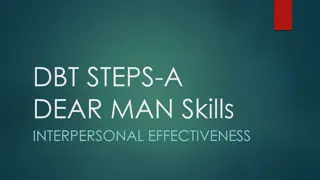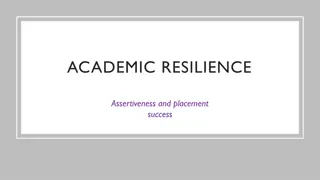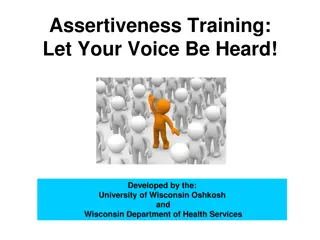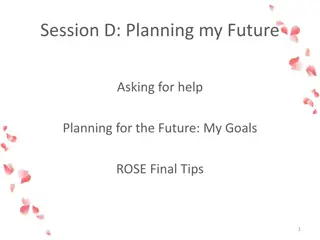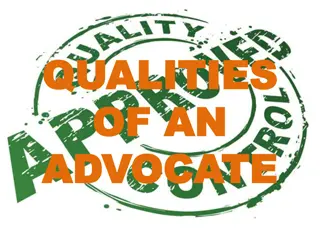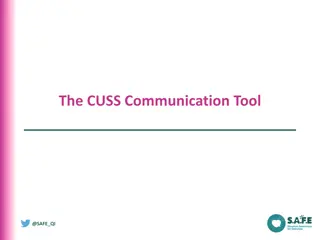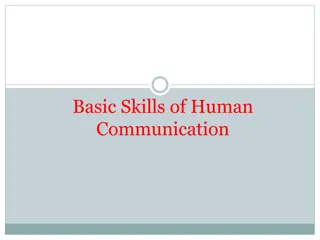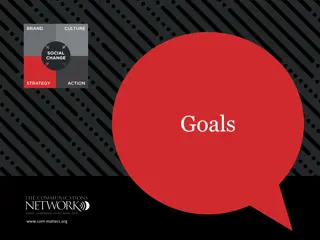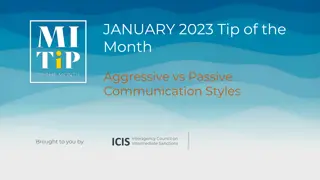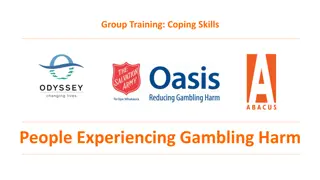Building Assertiveness Skills: A Guide to Effective Communication
Explore the concept of assertiveness, learn what it means to be an assertive person, and discover the characteristics of assertive individuals. This guide provides practical tips on how to become more assertive, including strategies for open communication, active listening, and conflict resolution. Embrace assertiveness as a positive way to communicate your needs, thoughts, and boundaries while respecting others.
Download Presentation

Please find below an Image/Link to download the presentation.
The content on the website is provided AS IS for your information and personal use only. It may not be sold, licensed, or shared on other websites without obtaining consent from the author. Download presentation by click this link. If you encounter any issues during the download, it is possible that the publisher has removed the file from their server.
E N D
Presentation Transcript
ASSERTIVENESS Adapted from CAPS Prezi by Cassandra Hernandez
WHAT DOES IT MEAN TO BE AN ASSERTIVE PERSON Standing up for your own or other people s rights in a calm and positive way. Assertive individuals get their point across without upsetting others or becoming upset themselves.
CHARACTERISTICS OF ASSERTIVE PEOPLE: Understand RESPECT Can relate to others in a sincere way Understand and value themselves Have self-control and emotional stability Develop their ability to communicate effectively Know their boundaries Emotionally independent
1. Decide to positively assert yourself 2. Aim for open and honest communication 3. Listen actively 4. Agree to disagree 5. Avoid guilt trips 6. Stay calm 7. Take a problem-solving approach to conflict 8. Practice assertiveness 9. Use I statements 10. Be patient HOW TO BECOME A MORE ASSERTIVE PERSON:
1. DECIDE TO POSITIVELY ASSERT YOURSELF Commit to being assertive rather than passive or aggressive and start practicing it now. The change needs to start from within, having that internal communication with yourself in a positive manner takes time. Be easy with yourself all while being able to pin-point the positives of having that switch from being aggressive to
2. AIM FOR OPEN AND HONEST COMMUNICATION Remember to respect other people when you are sharing your feelings, wants, needs, beliefs or opinions Respect is mutual so what you give you will get in return so treat others with respect and you will receive that same respect in return
3. LISTEN ACTIVELY Try to understand the other person s point of view and don t interrupt when they are explaining it to you
4. AGREE TO DISAGREE Remember that having a different point of view doesn t mean your right and the other person is wrong. Keeping an open mind when reeling in new ways of thinking will make it easier to learn the other person s way of thinking.
5. AVOID GUILT TRIPS Be honest and tell others how you fell or what you want without making accusations or making them feel guilty
6. STAY CLAM Breathe normally, look the person in the eye, keep your face relaxed and speak in a normal tone in your voice
7. TAKE A PROBLEM-SOLVING APPROACH TO CONFLICT Try to see the other person as your friend not your enemy
8.PRACTICE ASSERTIVENESS Talk in an assertive way in front of a mirror or with a friend. Pay close attention to your body language as well as the words you say.
9. USE I Stick with statement s that include I in them as much as I think or I feel . Don t use aggressive language such as you always or you never
10. BE PATIENT Being an assertive person takes practice . Remember that you will sometimes do better at it than at other times, but you can always learn from your mistakes.
WHY IT IS IMPORTANT TO BE ASSERTIVE? Build your communication It builds better confidence Stronger social bonds Creates boundaries with people Establishes mutual respect














